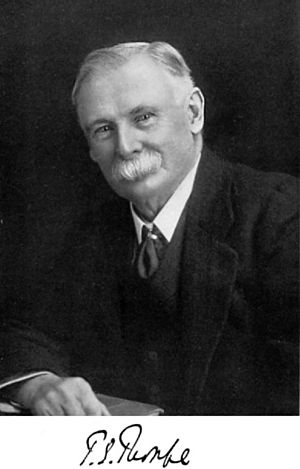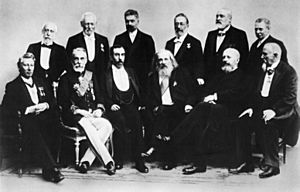Thomas Edward Thorpe facts for kids
Quick facts for kids
Thomas Edward Thorpe
|
|
|---|---|
 |
|
| Born | 8 December 1845 |
| Died | 23 February 1925 (aged 79) |
| Nationality | British |
| Alma mater | University of Heidelberg |
| Awards | Longstaff Prize (1881) Royal Medal (1889) |
| Scientific career | |
| Fields | Chemistry |
| Institutions | Normal School of Science Yorkshire College of Science Andersonian Institute |
| Doctoral advisor | Robert Bunsen |
| Doctoral students |
|
Sir Thomas Edward Thorpe (8 December 1845 – 23 February 1925) was an important British chemist. He worked for the British Government as the Chief Chemist from 1894 to 1909. He was also a respected professor and researcher.
Contents
Early Life and School Days
Thomas Thorpe was born in Harpurhey, Manchester, England. His father, George Thorpe, was a cotton merchant. Thomas went to Hulme Grammar School for his early education.
He first worked as a clerk. But in 1863, he started helping Henry Enfield Roscoe. Roscoe was a chemistry professor at Owen's College in Manchester. There, Thomas earned his degree in Chemistry. Later, he studied at the University of Heidelberg in Germany. He earned his PhD, which is a very high degree.
Becoming a Chemistry Professor
After working with August Kekulé in Germany, Thorpe came back to Britain. In 1870, he became a professor at the Andersonian Institute in Glasgow. This school is now known as the University of Strathclyde.
He later taught at other famous universities. These included the University of Leeds and Imperial College London.
Amazing Chemistry Discoveries
Thomas Thorpe studied many different things in chemistry. He helped us understand how the weight of a substance's tiny parts (its molecular weight) relates to how heavy it is compared to water (its specific gravity).
He also worked on chemicals containing phosphorus. His research helped people understand phosphorus trioxide better. This was important for preventing illnesses in workers who made matches.
Thorpe's work on the weights of atoms in metals was very important. He won the Royal Medal in 1889 for this work. In 1902, he joined the new International Atomic Weights Commission. This group helps set the official weights for all atoms.
He was also a member of the Royal Society, a famous group of scientists. He even went on four trips to study eclipses! He also helped map the Earth's magnetic field across the British Isles.
Working for the Government
In 1894, Thorpe left his university job. He started working for the British government. He became the head of the Government Laboratory. This lab was first set up to check if tobacco products were pure. Later, it also checked food and drugs.
As the head chemist, Thorpe moved the lab to a new building he designed. He made the lab much better and more respected. He and his team worked on important public health issues. For example, they found arsenic in beer and helped remove lead from pottery.
Awards and Recognition
Thomas Thorpe received many honors for his work. Queen Victoria made him a Companion of the Order of the Bath in 1900. Later, in 1909, King Edward VII made him a knight. This is why he is called "Sir" Thomas Edward Thorpe.
His Family Life
In 1870, Thomas Thorpe married Caroline Emma Watts. They did not have any children.
His Final Years
Sir Thomas Thorpe passed away on 23 February 1925. He was 79 years old. He died from a heart attack after being unwell for some time. He was buried in the churchyard in Salcombe, Devon.


